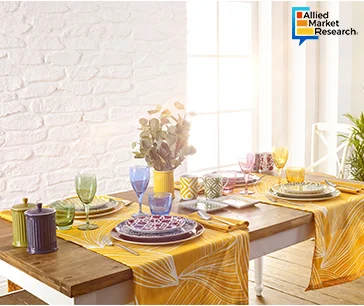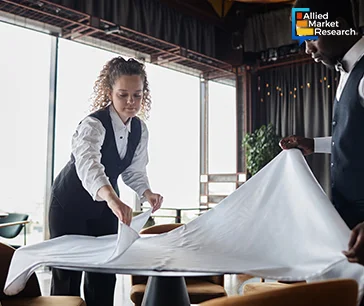Table Of Contents

Roshan Deshmukh

Pooja Parvatkar
Table Runner Market: Trends, Opportunities, and PESTLE

The table runner market has experienced a dynamic transformation, driven by customization, increased competition, and shift in consumer behavior and preferences. With a growing emphasis on home decor, consumers are increasingly interested in enhancing the visual appeal of their living spaces, driving the demand for stylish and versatile table runners. Seasonal and festive decor trends contribute to the popularity of table runners as quick and cost-effective accessories that allow individuals to update their dining tables for special occasions.
A table runner is a piece of ornamental cloth that is positioned lengthwise across the middle of a dining table. It is used to improve the table's appearance and provide the eating space with a decorative touch. Moreover, it serves for both functional and decorative purposes. It is available in a variety of colors, patterns, and materials to suit different table settings and interior decor styles. In addition, it also provides a layer of protection to the table surface which helps to prevent scratches, stains, or damage from hot dishes or utensils. The materials used for table runners vary and can include cotton, linen, silk, polyester, and blends.
An Uphill Trajectory for Table Runner Market?
The market was benefiting from several positive factors, including the growing interest in home decor, seasonal and festive decor trends, the convenience of e-commerce, and the versatility of table runners serving both aesthetic and functional purposes. Consumer preferences for sustainable materials and high-quality products also provided an additional avenue for growth, reflecting a market that was adapting to evolving trends and demands. The overall home decor market has observed a significant growth in recent years. The leading home decor importers include U.S. ($67.7 Billion), Germany ($19 Billion), UK ($11.2 Billion), France ($11 Billion), Japan ($8.2 Billion), Canada ($8.1 Billion), Australia ($6.2 Billion), Netherlands ($5.9 Billion), Italy ($5.8 Billion), and China ($5.3 Billion).
Trends in Table Runner Market
The demand from consumers for environmentally friendly and sustainable products has been rising, globally. Moreover, with rising emphasis on organic and recycled textiles, this trend has impacted the choice of materials used to make table runners along with sustainable manufacturing techniques. This trend aligns with the broad movement toward eco-conscious consumerism.

The personalization trend has been fueled by growth in consumers' demand for unique and personalized home decor items. Table runners offer an opportunity for customers to express their uniqueness, which helps them to showcase their individuality. Manufacturers have introduced customers to personalized table runners to fit their style and preferences by providing customization choices such as monogramming, unique designs, or the chance to select specific colors and patterns.
In recent years, there has been a discernible shift in consumer preferences towards table runners as essential elements in enhancing the aesthetic appeal of dining spaces. The industry is experiencing a surge in demand for customizable and unique table runners that not only protect surfaces but also serve as a statement piece, reflecting individual tastes and styles. This trend is driven by a growing emphasis on personalized home decor, where consumers seek products that add a touch of elegance and uniqueness to their living spaces.
Additionally, sustainability is one of the major emerging trends in the table runner market. As eco-conscious consumers seek environmentally friendly options, manufacturers are responding by introducing sustainable materials and production processes. This shift aligns with the broader trend of sustainability in home goods, reflecting a conscientious effort to reduce the environmental impact of products while providing customers with eco-friendly choices.
Table runners have been treated as a multipurpose element owing to the growth in trend of functional and efficient home decor. This trend also incorporates built-in pockets or compartments for storing silverware which has transformed the table runner from a purely decorative piece to a useful tool for arranging dining necessities.
Consumers are attracted to designs that reflect global cultures and traditions. In the table runner market, this trend has involved the incorporation of patterns, motifs, and color schemes which is inspired by diverse cultures around the world. In addition, it adds a unique aesthetic to the product and also allows consumers to connect with different cultural influences which has positively impacted market growth.
The texture of the table runner plays a crucial role in enhancing the visual appeal of table runners. Manufacturers have experimented with a variety of materials, including unconventional fabrics and weaving techniques to create unique textures. This trend has resulted in a diverse range of table runners including smooth and sleek surfaces and rich texture and tactile qualities.
The prevalence of online shopping has continued to influence consumers access and purchase home decor items. Moreover, the e-commerce platforms and online retailers play a dominant role in the distribution of table runners. In addition, to deal with competition of the market manufacturers are focusing on enhancing the online customer experience by providing detailed product information, high-quality images, and user-friendly customization options on their websites.
Growth Opportunities in the Table Runner Industry
The table runner market presents growth opportunities through customization trends, eco-friendly materials, expanding hospitality sectors, online retail platforms, and innovative design collaborations.

Rise in customization services to cater to individual tastes
The demand for personalized and unique home decor items presents an opportunity for manufacturers in the table runner market to offer customization services owing to consumer desire for individualized and distinctive home decor goods. Moreover, companies are able to capitalize on the desire for customized products by letting customers select colors, patterns, and even add personalized components. The use of online platforms that are easy to use for customization have improved the customer experience by facilitating the creation of custom table runners by customers which has presented opportunity in the market.
Increased innovation in sustainable materials and manufacturing
The growth in consciousness of environmental sustainability has presented prospects for enterprises to introduce novel materials and production techniques. Moreover, the creation of table runners from sustainable materials such as recycled fabrics, organic cotton, or other eco-friendly alternatives have attracted customers who care about the environment. The adoption of ethical and sustainable production techniques has also improved organizations’ reputation. Furthermore, it has also drawn the attention of the consumer segment that is concerned with making environmentally favorable decisions.

Expanding Online Presence and E-commerce Strategies
E-commerce businesses in the table runner industry hold the opportunity to enhance their online presence and improve their e-commerce tactics due to the sustained expansion of online retail. This includes developing user-friendly websites, investigating online markets, and utilizing social media channels for marketing. In addition, it will help to draw in more customers and boost sales by improving the online shopping experience with crisp, high-quality images, thorough product information, and safe transaction procedures.
PESTEL Analysis?
Understanding and adapting to these PESTEL factors is essential for the key players in the table runner market. It allows them to navigate external influences, identify opportunities, and proactively address challenges to remain competitive and responsive to the dynamic market environment.
Political Factors:?
- Import Regulations and Compliance: The changes in political landscapes and trade policies have negatively impacted on the import and export of materials used in table runner production. Moreover, tariffs, trade agreements, and geopolitical tensions have also affected the cost and availability of raw materials.
- Government Stability: Political stability has a major influence on consumer confidence and the overall economic environment which further affects the consumer spending on non-essential items such as home decor.
Economic Factors:?
- Level of disposable income: The economic conditions, such as levels of disposable income directly impact consumer spending on luxury and non-essential items such as table runners.
- Inflation Rates: Fluctuations in inflation rates affect the cost of production. This potentially impacts the pricing strategies within the market of table runner.
Social Factors:
- Consumer Preferences: The fluctuation in social trends and changes in consumer preferences for home decor styles and aesthetics have significantly influenced the demand for specific types of table runners.
- Lifestyle Changes: Shifts in lifestyle, such as an increased focus on entertainment at home, have led to a higher demand for decorative items such as table runners.
Technological Factors:
- Rise in digitalization: Rise in advancements in digital technologies have positively impacted the way table runners are marketed and sold. The e-commerce platforms and online retailers have played a crucial role in distribution.
- Manufacturing Technologies: Growth in innovations in manufacturing processes have positively affected the efficiency, production costs, and the ability to create new and unique designs.
Environmental Factors:
- Rise in demand for sustainable Practices: The increase in awareness of environmental issues has driven consumer preferences for eco-friendly materials and sustainable manufacturing practices in the production of table runners.
- Waste Management: Regulations related to waste management and environmental impact have influenced the choice of materials used in manufacturing.
Legal Factors:
- Regulatory Compliance: Compliance with regulations related to product safety, labeling, and environmental standards is essential in the manufacturing and marketing of table runners.
- Intellectual Property: Protection of intellectual property rights, such as design patents or trademarks, is crucial for companies in the table runner market to prevent imitation and ensure market competitiveness.
The Future of Table Runner Market
The future of the table runner market is poised for evolution with a focus on sustainable practices, including eco-friendly materials and manufacturing processes. Customization trends driven by digital technology are expected to flourish, catering to diverse consumer preferences. Additionally, growing demand from hospitality and event industries will further propel market growth and innovation. For further insights on the market, get in touch with AMR analysts.

